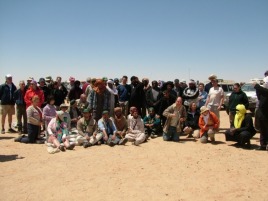Libya: Indigenous Ethnic Groups
Small Population, Great People
By: Anna Maria Katosoyannis

Libya is a large African country with a small population. Within this population are different indigenous ethnic groups of people. Natives are primarily Arabs and Berbers. However, there are also tribal groups in southern Libya, such as the Tebou and Touareg tribes. These groups live together peacefully.
Ever since the Arabs conquered Libya in the seventh century A.D., Arab invaders brought their language and culture with them. During this time, intermarriages with Berbers and other indigenous people produced a mix of ethnic groups in Libya. 90% percent of Libya’s population is made of this mix of Arab-speaking Muslims and Berber ancestry. The other ten percent is made up of tribal groups (Tebou and Touareg), and a mix of other kinds of people such as, Greeks, Muslim Cretans, Maltese, Armenians, and other North Africans. Oddly enough, fifty percent of Libya’s population is estimated to be under the age of fifteen (U.S. Department of State, 1).
The people of Libya were not greatly affected by the slave trade. They were however affected by European colonialism. Between 1911 and 1949, a lot had changed in Libya (Tore Kjeilen, 3). Italian invaders battled for the control of Libya in 1911. As a result, the Ottoman Empire took control over Libya. But in 1943, Britain and France took control. They divided Libya by its major cities. Tripolitania and Cyrenaica became under British control, while Fezzan became under French control. This division not only separated the cities, but also separated the people. After this, there had been a constant fight over the control of Libya. Hardship came to Libyan’s as well. In the early 1930’s many natives were imprisoned in great camps, while others fled the country for safety. Italian colonization meant more Italians in Libya. However, by 1947 there were only an estimated 40,613 Italians left in Libya, and their numbers continued to dwindle into the 1950s (Jon G., 3)
The control over Libya greatly affected its people. Libya’s economy has suffered since. Recently, domestic food production meets about 25% of demand (U.S. Department of State, 4). This food shortage causes starving and deaths. Despite their problems, the groups of Libya come together to help other nations. For example, Libya has played a helpful role in facilitating the provision of humanitarian assistance to Darfur refugees in Chad (U.S. Department of State, 4). It is apparent that these groups have hardships and many problems in their country, but they remain peaceful while keeping the country strong.
Bibliography
This was a helpful resource for me. From this Website, I obtained a great deal of information about Italy's colonization of Libya. It also gave me information on how this colonization affected the people of Libya.
Kjeilen, Tore. "Libya/History." LookLex Encyclopedia. 2009. http://looklex.com/e.o/libya.history.htm.
This source was not very helpful. It mostly gave me information through dates. I had to look at other sources for a more complex summary of what happened.
"Libya." U.S. Department of State Background Note. Feb. 2007. http://www.infoplease.com/country/profiles/libya.html.
This was a very helpful source. In fact, it was my most helpful. It gave me all of the history of these people and how they reacted to all of the changes in Libya. It also gave be more information on the various dates I learned about in a previous source.
"Peoples of Libya." Geographic. 2004. http://photius.com/countries/libya/society/libya_society_ethnic_groups_and_languages.
This source gave me a very broad explanation of the ethnic groups in Libya. However, I thought this was very helpful. It was my first source.

